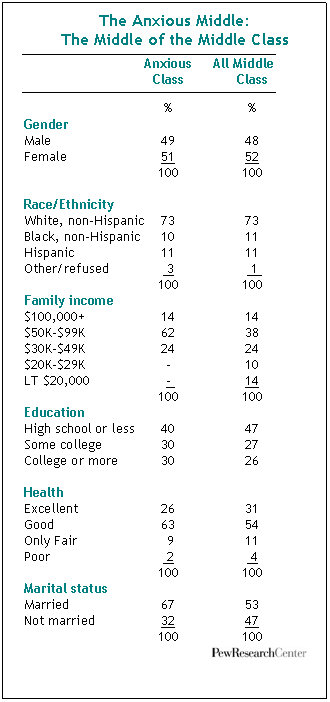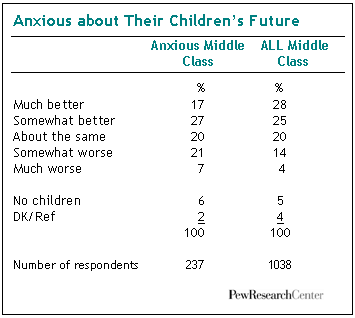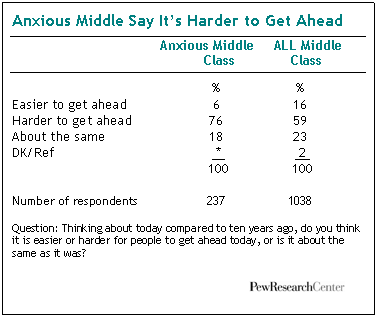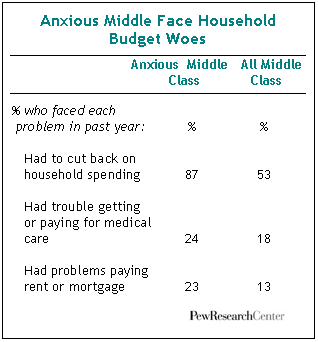23% of the Middle Class; 12% of all adults
These working and worried Americans are the most middle class of the four middle class groups. Members of this group aren’t the wealthiest or the least affluent of the four groups, nor are they the oldest or the youngest group. In terms of education, too, they come closest to the median for the middle class as a whole. In fact, on most key measures of social standing they fall comfortably and consistently in the middle. Overall, they comprise 23% of all self-identified middle class Americans, or about 12% of all Americans.
 On the surface, these middle class Americans seem to be living the American Dream. But they say they’re not, and their distinctly bleak judgments of their lives and the future stand in sharp contrast to their seemingly comfortable circumstances and distinguish them from each of the other three groups.
On the surface, these middle class Americans seem to be living the American Dream. But they say they’re not, and their distinctly bleak judgments of their lives and the future stand in sharp contrast to their seemingly comfortable circumstances and distinguish them from each of the other three groups.
The Anxious Middle is the most likely of any group to be dissatisfied with the “way things are going in this country.” Looking inward, only 16% are highly satisfied with their lives, fully half the proportion of the middle class as a whole.
They are the most likely of any group to say it’s harder for people to get ahead today than 10 years ago, and they’re the least likely to predict that their children will do better than they did in life.
Why so glum? The survey suggests these members of the middle class are financially vulnerable, despite their comparatively high incomes.
They are disproportionately more likely than the middle class as a whole to say they had to cut back on household spending in the past year or to report that they had trouble paying their rent or mortgage.
And there’s more trouble ahead, many in the Anxious Middle fear: Nearly a quarter say it’s likely they will be laid off or fired in the coming year, nearly double the proportion of the middle class as a whole.
Who They Are
As befits their position in the middle of the middle class, they’re neither particularly affluent nor are they poor. More than seven-in-ten have family incomes of $50,000 or more, and nearly a third earn more than $75,000. No one in this group earns less than $30,000.
About three-in-ten are college graduates, similar to the proportion of college-educated in the middle class. About half are women (51%) and about half are men (49%), making this the only middle class group in which one gender does not predominate.
The median age of the Anxious Middle is 43 years old—one year less than the median age of the middle class as a whole. Nearly six in ten (59%) are between the ages of 30 and 49 while only 3% are 65 or older and 13% are under the age of 30.
 They are the most likely to be employed full time (76%) and the least likely to be retired (5%). Fully two-thirds are married compared with about half of the middle class as a whole.
They are the most likely to be employed full time (76%) and the least likely to be retired (5%). Fully two-thirds are married compared with about half of the middle class as a whole.
Along with the Top of the Class, they are most likely to own their homes; fully eight-in-ten (81%) are homeowners. (In fact, on a number of financial measures the Anxious Middle and the Top of the Class are similar.)
They’re the most likely to say their home represents more than half of their net worth. But 61% say they’ve paid off less than half their mortgage, compared with 44% of all middle class homeowners. And they are far more likely than others in the middle class to say they have taken out a second mortgage on their homes or a home equity loan (42% vs. 29%).
What They Think
 These married, working, home-owning Americans would seem to have it all. But they say they don’t, and in terms of their overall levels of satisfaction, they’re not particularly happy with their lives. More than eight-in-ten (84%) rate their ladder-of-life standing as “medium” or “low”—easily the largest proportion of any group to place themselves in these categories—and of these, fully four-in-ten (40%) place themselves on the lowest rungs of the ladder.
These married, working, home-owning Americans would seem to have it all. But they say they don’t, and in terms of their overall levels of satisfaction, they’re not particularly happy with their lives. More than eight-in-ten (84%) rate their ladder-of-life standing as “medium” or “low”—easily the largest proportion of any group to place themselves in these categories—and of these, fully four-in-ten (40%) place themselves on the lowest rungs of the ladder.
Their dissatisfaction reaches beyond their own lives. They are the most dissatisfied of any group with the way things are going in this country (76% vs. 61% for the middle class as a whole); barely two-in-ten say they’re satisfied (21%). They’re even more sour about the current state of the economy than the Struggling Middle: 33% say the nation’s financial condition is “poor,” the largest proportion of any of the groups, while another 54% say it’s “not so good.”
These gloomy Americans see tough times for their children: 28% say they expect their children will do worse in life than they themselves have done, the largest proportion of any middle class group. They are the most likely of any group to say it’s harder for people to get ahead today, a view shared by 76% of them, 17 percentage points more than other self-identified members of the middle class and 13 percentage points more than the Struggling Middle. And they are at least as cynical as the most disadvantaged members of the middle class: 78% agree that the “rich just get richer while the poor get poorer,” a view they share with 79% of those in the most pressured middle class group.
Why They Are Unhappy
 On virtually every key measure they rank only behind the Struggling Middle as having experienced the most economic problems in the past year: 23% say they had problems paying their rent or mortgage, 25% say they couldn’t afford or otherwise get needed medical care, 41% say they or someone in their household had to start working or take on an extra job to help pay the bills and 12% say they lost their job.
On virtually every key measure they rank only behind the Struggling Middle as having experienced the most economic problems in the past year: 23% say they had problems paying their rent or mortgage, 25% say they couldn’t afford or otherwise get needed medical care, 41% say they or someone in their household had to start working or take on an extra job to help pay the bills and 12% say they lost their job.
Also, they are just as likely as the Struggling Middle to say they had to cut back on household spending because money was tight (87% vs. 53% for the middle class as a whole).
Looking ahead, they see a future nearly as troubled as the one envisioned by the Struggling Middle. Half say they will have trouble paying their bills. Nearly nine-in-ten predict they’ll have difficulty saving. And more than eight-in-ten expect they will have to cut back on household spending because money is tight. More than two-in-ten (23%) fear they will lose their job in the coming year. These anxious middle class Americans rank second only to the Struggling Middle in their bleak responses to all these questions.


